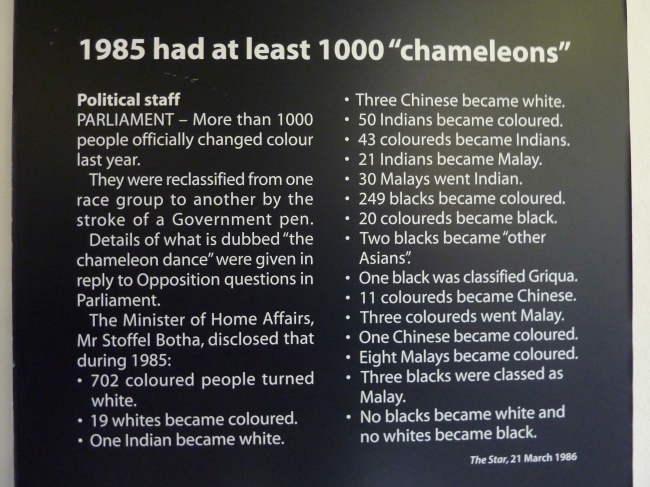
By Margaret Zhang and Anisha Suterwala
Hello, Anisha and Margaret reporting live from Johannesburg! As some dedicated readers might have seen, our own Globalista, Dianne, wrote a fantastic blog post about being a black girl in a largely white group of students spending time in the majority white parts of Cape Town. Throughout this trip, taxi drivers, interviewees, and hostel owners have continuously noted the divide between blacks, whites, and colored people. This is illustrated through the distinction of “black townships” versus “colored townships.” This caused us, an Indian-American and a Chinese-American, to have a fair amount of racial confusion. After all, aren’t we used to “colored” being a.) a racist term, and b.) a horribly anachronistic and unacceptable term for blacks in America? If “black” was a separate racial category in South Africa, who exactly is colored? Would we have been forced into a colored township if we lived here during the apartheid years? Were we going to face discrimination on this trip? Taxi drivers gave us unclear answers when we asked “What races count as colored?” so we decided to do a little investigation work.
Historically, the Indian population first came to South Africa as indentured servants and later as traders and British subjects. The Chinese population increased in the 1870s as a gold rush began in South Africa. Later, in 1904, the Chinese Exclusion Act was passed, and ill sentiment towards the Chinese prevailed.
During the apartheid years, Indians and Chinese people were classified as “colored” under the 1950s Group Areas Act, which moved people into designated township. In the beginning, “colored” just meant non-white, non-aboriginal, and non-tribal African. Throughout the years, “colored” was more stringently defined, and came to have classifications like Cape Malay, Cape Colored, Chinese, and Other Colored. We believe that Indian became a separate category, but our research has been fuzzy as of far. After early apartheid, it became more apparent how fluid race was for non-black and non-white people. Chinese and Indians, along with other “colored’ races could petition and legally change their designated race. The sign below was featured at the Johannesburg’s Apartheid Museum, and shows the types of racial changes that occurred in those years.
In the post-apartheid years, both Indians and Chinese people who had a family legacy of discrimination under apartheid fought for, and legally gained the right to qualify as “Black” underneath the Black Economic Empowerment strategy, which gives disadvantaged groups economic privileges.
What we’ve noticed is the fluidity of our races—it doesn’t seem well defined where our races fall into South Africa’s deep racial divide. From the social dynamics that we’ve seen in our week and a half here, we don’t really know if there still is discrimination against Indian and Chinese people, but if there is, we haven’t felt it. Anisha has gotten the occasional “Namaste” and Margaret has gotten “Konichiwa,” “Anyong Haseyo,” and “Ni Hao,” but that’s the only distinguishing factor that we’ve noticed. Perhaps though, it’s just a matter of having an American accent.
Note: “Colored” is apparently non-offensive and very frequently used here.
